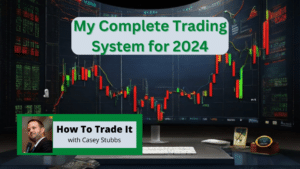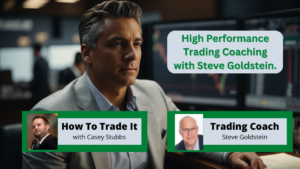Bill Provenzano’s Incredible Journey From Law School Aspirations to Trading Success

Welcome to another exciting episode of the “How to Trade It” podcast. Coach Bill Provenzano has an extensive 30-year trading career and a fascinating journey that led him to the world of trading. You aren’t going to want to miss this lively discussion!
Podcast highlights include…
Bill’s Journey Begins
- In 1985, fresh out of high school, Bill was headed for law school until a chance encounter led him to a trading floor.
- Bill describes the awe-inspiring moment he first witnessed the trading floor at the Chicago Mercantile Exchange.
From Runner to Desk Manager
- Bill talks about starting as a runner, delivering orders on the trading floor.
- His rapid promotion to desk manager and his aspiration to become a trader.
- The allure of trading and the realization that traders were the ones making money.
Trading at Mid America Exchange
- Bill’s transition to trading at the Mid America Exchange within the Chicago Board of Trade.
- Trading mini contracts, including third-year treasury bond futures and soybean futures.
- The chaos of open outcry trading and colorful jackets.
- Bill’s move to the Chicago Mercantile Exchange and trading Eurodollar futures.
- A glimpse into the world of 30-day interest rate futures.
- Bill’s trading journey from 1991 to 2006.
Choosing Trading Over Law
- Casey questions Bill’s decision to leave behind a potential career in law.
- Bill reflects on the energy, excitement, and unlimited potential he saw in trading compared to the legal profession.
- The contrast between his father’s law career and the allure of the trading floor.
Subscribe to How To Trade It
Eurodollar Futures
Eurodollar futures, also known simply as “Eurodollars,” are interest rate futures contracts that provide a way to speculate on or hedge against fluctuations in short-term U.S. dollar interest rates. Despite their name, Eurodollar futures have no direct connection to the European currency. Instead, they derive their name from the fact that they were initially based on U.S. dollar deposits held in European banks, specifically in offshore accounts.
The primary underlying asset of Eurodollar futures is the three-month U.S. dollar-denominated time deposit, which is held in offshore, non-U.S. banks. This deposit typically represents a short-term loan or investment made in U.S. dollars and is governed by international banking regulations. Eurodollar futures contracts allow traders to wager on the future value of the interest rate paid on these deposits. The contracts are based on the notional principal value of a $1 million deposit.
These futures contracts are listed and traded on various futures exchanges, with the Chicago Mercantile Exchange (CME) being one of the most prominent markets for Eurodollar futures. Each contract has a specific expiration date, usually on a quarterly basis (March, June, September, and December), corresponding to the maturity date of the underlying Eurodollar deposit. Traders can choose from a variety of contract expirations to suit their trading or hedging needs.
Eurodollar futures are highly liquid, making them attractive to a wide range of market participants, including institutional investors, banks, multinational corporations, and individual traders. This liquidity is due, in part, to their importance in global financial markets and the extensive trading volume they generate.
One of the primary uses of Eurodollar futures is to manage interest rate risk. For example, if a bank expects interest rates to rise, it may sell Eurodollar futures contracts to hedge against potential losses on its portfolio of fixed-rate loans. Conversely, if a corporation anticipates needing to borrow money in the future, it may use Eurodollar futures to lock in favorable borrowing rates.
Moreover, Eurodollar futures play a critical role in the broader financial ecosystem. They serve as a vital benchmark for pricing various financial instruments, such as interest rate swaps and options. The yield curve constructed from Eurodollar futures prices provides valuable insights into market expectations regarding future interest rates.
Mini Contracts
Mini contracts, also referred to as mini futures or E-mini contracts, are a derivative financial instrument designed to provide traders with more accessible and cost-effective exposure to the underlying asset or index compared to their standard-sized counterparts. These contracts are characterized by their reduced size and lower margin requirements, making them appealing to individual investors and traders with smaller capital bases.
Mini contracts can cover a wide range of assets, including equity indices, commodities, currencies, and interest rates. While they offer similar profit potential and price movements as standard contracts, their smaller size allows traders to enter the futures markets with less capital and risk. This accessibility has democratized futures trading, enabling a broader range of market participants to engage in various trading strategies and risk management activities within the futures arena.
Thanks for joining us on this enlightening episode of the “How to Trade It” podcast. We hope you enjoyed hearing about Bill Provenzano’s incredible journey from aspiring lawyer to successful trader. Stay tuned for more inspiring stories and valuable insights from the world of trading on upcoming episodes. Remember, you can download or listen to this episode on Spotify.
Connect with Bill Provenzano
- Website: http://tradingcoachbillpro.com
- Trading With Faith: 12 Biblically Inspired Principles For Trading Success by Bill Provenzano
Connect with Casey:
- Website: https://caseystubbs.com
- YouTube: https://www.youtube.com/TradingStrategyGuides
- YouTube: https://www.youtube.com/caseystubbs
- Facebook: https://www.facebook.com/TradingStrategy
- LinkedIn: https://www.linkedin.com/in/caseystubbs
- Twitter: https://twitter.com/caseystubbs316
- TradingStrategyGuides.com: https://www.tradingstrategyguides.com/
- Global Prop Trader: https://globalproptrader.com/
- Email: podcast@tradingstrategyguides.com
Subscribe to How To Trade It






